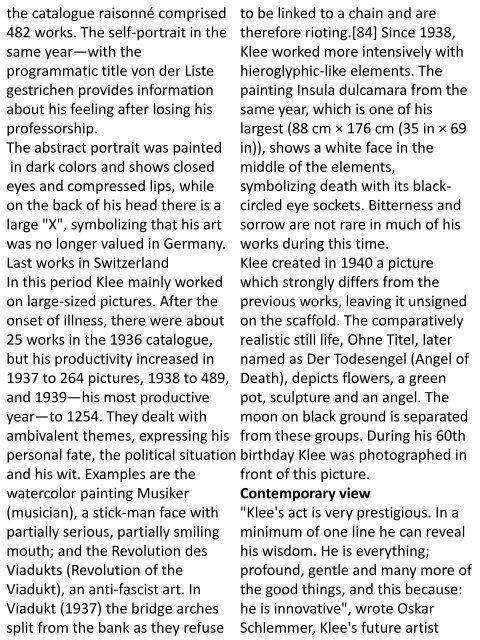Aziz Art July 2019
History of art(west and middle east)- contemporary art ,art ,contemporary art ,art-history of art ,iranian art ,iranian contemporary art ,middle east art ,european art
History of art(west and middle east)- contemporary art ,art ,contemporary art ,art-history of art ,iranian art ,iranian contemporary art ,middle east art ,european art
Create successful ePaper yourself
Turn your PDF publications into a flip-book with our unique Google optimized e-Paper software.
the catalogue raisonné comprised<br />
482 works. The self-portrait in the<br />
same year—with the<br />
programmatic title von der Liste<br />
gestrichen provides information<br />
about his feeling after losing his<br />
professorship.<br />
The abstract portrait was painted<br />
in dark colors and shows closed<br />
eyes and compressed lips, while<br />
on the back of his head there is a<br />
large "X", symbolizing that his art<br />
was no longer valued in Germany.<br />
Last works in Switzerland<br />
In this period Klee mainly worked<br />
on large-sized pictures. After the<br />
onset of illness, there were about<br />
25 works in the 1936 catalogue,<br />
but his productivity increased in<br />
1937 to 264 pictures, 1938 to 489,<br />
and 1939—his most productive<br />
year—to 1254. They dealt with<br />
ambivalent themes, expressing his<br />
personal fate, the political situation<br />
and his wit. Examples are the<br />
watercolor painting Musiker<br />
(musician), a stick-man face with<br />
partially serious, partially smiling<br />
mouth; and the Revolution des<br />
Viadukts (Revolution of the<br />
Viadukt), an anti-fascist art. In<br />
Viadukt (1937) the bridge arches<br />
split from the bank as they refuse<br />
to be linked to a chain and are<br />
therefore rioting.[84] Since 1938,<br />
Klee worked more intensively with<br />
hieroglyphic-like elements. The<br />
painting Insula dulcamara from the<br />
same year, which is one of his<br />
largest (88 cm × 176 cm (35 in × 69<br />
in)), shows a white face in the<br />
middle of the elements,<br />
symbolizing death with its blackcircled<br />
eye sockets. Bitterness and<br />
sorrow are not rare in much of his<br />
works during this time.<br />
Klee created in 1940 a picture<br />
which strongly differs from the<br />
previous works, leaving it unsigned<br />
on the scaffold. The comparatively<br />
realistic still life, Ohne Titel, later<br />
named as Der Todesengel (Angel of<br />
Death), depicts flowers, a green<br />
pot, sculpture and an angel. The<br />
moon on black ground is separated<br />
from these groups. During his 60th<br />
birthday Klee was photographed in<br />
front of this picture.<br />
Contemporary view<br />
"Klee's act is very prestigious. In a<br />
minimum of one line he can reveal<br />
his wisdom. He is everything;<br />
profound, gentle and many more of<br />
the good things, and this because:<br />
he is innovative", wrote Oskar<br />
Schlemmer, Klee's future artist

















